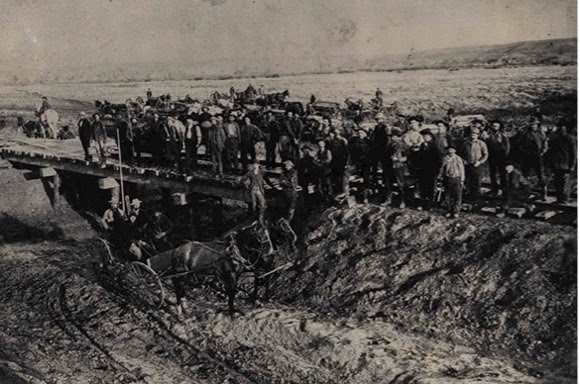July 2021
|
A is for Articulated: Learn the Railroad ABCs Did you know the term “beans” on the railroad means it’s time to eat? Ever heard of a gandy dancer? What’s a mother and slug? Did you know that a shoo-fly is a railroad term for a by-pass track? The rail industry has its own unique vernacular that has developed over nearly 200 years and is used by railroaders and railfans alike. BNSF has curated an industry-specific alphabet for rail enthusiasts who want to brush up on their rail knowledge or learn something new. 
A gandy dancer was a track laborer
BNSF Identifies Two New Rail-served Sites for Development One way BNSF works to ensure the right solution is offered to each customer is by scouting out potential sites for development in advance of customer inquiries. BNSF's Site Certification Program identifies optimal rail-served sites and conducts in-depth reviews of ten economic development criteria to determine if the site meets BNSF’s stringent readiness standards. BNSF certification ensures a site is ready for rapid acquisition and development. Selecting a certified site can reduce development time, increase speed to market and reduce upfront development risk of rail-served industrial sites. Last month, BNSF awarded two new locations its Certified Sites designation, including a Poplar Montana site:
BNSF Firefighting Trains Help Stop Wildfires BNSF trains operate across much of the West, including areas where high winds and drought conditions can result in wildfires on or near tracks. BNSF takes steps to prevent fires but they often occur from other sources like lightning strikes, trespassers, etc., and the sooner they’re put out, the sooner train service can get back on track.
To combat wildfires, BNSF has tank cars full of water staged in areas prone to fire conditions. The trains are specially equipped to fight fires on BNSF tracks or structures as well as provide assistance to local fire departments. In addition to getting firefighters to places that firetrucks can’t access and where there are no water sources, BNSF’s fire trains can carry 30,000 gallons of water. By comparison, a firetruck averages 500 gallons of water.
“BNSF prepares to respond to all different types of weather related events – wildland fires are such an event,” said Danniel MacDonald, BNSF’s general director of line maintenance. “Multiple departments all work together – in a Wired Tight effort – to prepare and safely respond. Communication and coordination with public agencies is key to our success.”

BNSF Urges Safety Around Tracks and Trains As summer weather inspires more exploration and adventure, it’s important to remember the dangers inherent in driving over or walking over rail tracks. A typical freight train can take more than a mile to stop, even when emergency brakes are applied—the distance of 18 football fields! While the number of highway-rail crossing collisions, deaths and injuries has dropped over the past five decades, it’s still a fact that a person or vehicle is struck by a train roughly once every three hours. Nearly all rail-related deaths involve drivers trying to beat a train, or people trespassing on railroad tracks.
Learn more about how to be safe around tracks and trains here.
Weekly U.S. Freight Rail Traffic Freight rail traffic volumes are a useful gauge of broader economic activity, both for specific industries and for the economy as a whole.

PNWER Summit Returns for 2021 BNSF is proud to be a sponsor of Pacific Northwest Economic Region’s (PNWER) 2021 Annual Summit which will take place August 15-19 in Big Sky, Montana. Postponed in 2020 due to the pandemic, the PNWER Annual Summit returns in 2021 as the leading forum where people in the policy and business come together to solve regional challenges. Due to the ongoing COVID-19 pandemic and the continued closure of the Canada-U.S. border to non-essential travel, PNWER is currently planning the 2021 Summit as a hybrid event.
Learn more and register on the PNWER website.
Supporting Our Communities
The BNSF Railway Foundation invests in the communities across the 28 states through which BNSF operates, and where BNSF employees live, work and volunteer. Recent donations include: Giving the Gift of Music to Southeast Wyoming The Cheyenne Symphony Orchestra is a professional orchestra that has been serving the city of Cheyenne and southeast Wyoming for 65 years. The orchestra provides musical enjoyment, growth and cultural outreach, and acts as a catalyst for other cultural and educational events that contribute to the quality of life for residents of Cheyenne and the surrounding areas. A grant from the BNSF Railway Foundation helps make it possible for symphony to give the gift of music to the community through concerts and educational outreach. Supporting Housing for Single-Parent Families in Casper, WY Seton House is a self-sufficiency program for single-parent families experiencing homelessness. Located in Casper, Wyoming, the goal of Seton House is to help families become independent. Since its opening in 1989, Seton House has grown from only three apartments used for emergency shelter to now 30 apartments, a learning center for children services, and a donation center. To support the organization’s work, BNSF Railway Foundation contributed toward Seton House maintenance.
|







